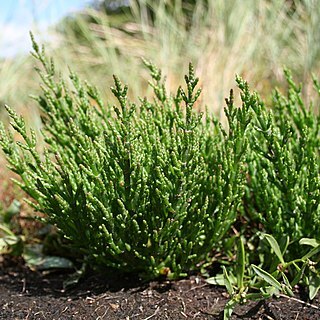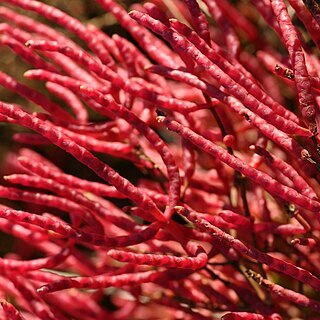Herbs, annual, fleshy, glabrous. Stems prostrate to erect, simple to many-branched, apparently jointed and fleshy when young, becoming not jointed and somewhat woody with age. Leaves opposite, connate basally, sessile, decurrent portions forming fleshy segments enclosing stem, fleshy; blade reduced to fleshy scales, margins entire, narrow, scarious. Inflorescences spikes, terminal on each stem, apparently jointed, each joint (fertile segment) consisting of 2 axillary, opposite, usually 3-flowered cymes embedded in and adherent to fleshy tissue of distal internode; flowers in each cyme arranged in triangle, the 2 lateral flowers meeting beneath central flower, flowers separated by persistent flaps of internodal tissue. Flowers usually bisexual, ± radially symmetric; perianth segments persistent in fruit, usually 3, connate except for extreme tips, fleshy; stamens (0-)1-2; styles 2. Fruits utriclelike; pericarp membranous. Seeds vertical, ellipsoid; seed coat yellowish brown, thin, membranous, hairy; perisperm absent. x = 9.
Fls perfect or pistillate, in groups of 3 and deeply sunken in pits in the axis of a fleshy spike above the axils of scale-like bracts; cal obpyramidal, fleshy, not lobed, opening by a small terminal slit only, becoming spongy at maturity; stamens 1 or 2, the anthers exsert; ovary laterally compressed; styles 2, short; fr enclosed in the cal, the pericarp none; annual or perennial succulent herbs with jointed, usually freely branched stems, the lvs reduced to minute, opposite, scarcely projecting scales; uppermost scales crowded, forming a cylindric terminal spike. All spp. vary greatly in height and branching; all branches normally terminate in a spike, the fls appearing in late summer. The plants often turn bright red in autumn. (Sarcocornia) 25, widespread.
Herbs or small shrubs. Stems erect or ascending, glabrous; branches opposite, fleshy, jointed. Leaves opposite, undeveloped, scale-like. Inflorescence terminal, pedunculate, spicate, cylindric. Flowers 1-3 borne on axil of a fleshy bract, sessile, appearing sunken into fleshy rachis, without bractlets, bisexual. Perianth 4-or 5-lobed, spongy and flattened apically in fruit, with top surface subrhomboid. Stamens 1 or 2. Style very short; stigmas 2, subulate. Fruit a utricle, enclosed by perianth. Seed vertical, compressed; embryo annular; perisperm absent.
Fls (1)-5-10-(15) per cluster in axils of uppermost lvs or bracts, forming a simple or branched spike. Per. ± 3-lobed, ± immersed; bracteoles 0; stamens 1-2; seed often hairy. Woody perennials to annuals of saline areas, with succulent opp. lvs, the pairs fused to form "segments" or "joints" surrounding the stem, tips us. free. A genus of some 50 spp., widespread, especially coastally.
Annual herbs, sometimes becoming thinly woody below, glabrous, seemingly leafless, built up of numerous superposed, more or less tubular-segments which are green to reddish and succulent, and ultimately shrivel, each segment at apex forming a little cup, usually with two short teeth, embracing the base of the next higher segment.
Flower minute, hermaphrodite, usually in clusters of three (always in the Flora Zambesiaca area), more or less connate, a pair of clusters to each fertile segment, the clusters on opposite sides and immersed.
Fertile segments aggregated into spikes at ends of stem and lateral branches, the latter often very short.
Perianth minutely 3–4 denticulate, opening in the middle of a truncate flattened lateral shield.
Spikes not disarticulating, persistent or breaking up irregularly.
Embryo folded so that radicle and cotyledons point downwards.
Seeds with thin membranous testa, minutely hairy.
Stamens usually 2 per flower.
Endosperm absent.


